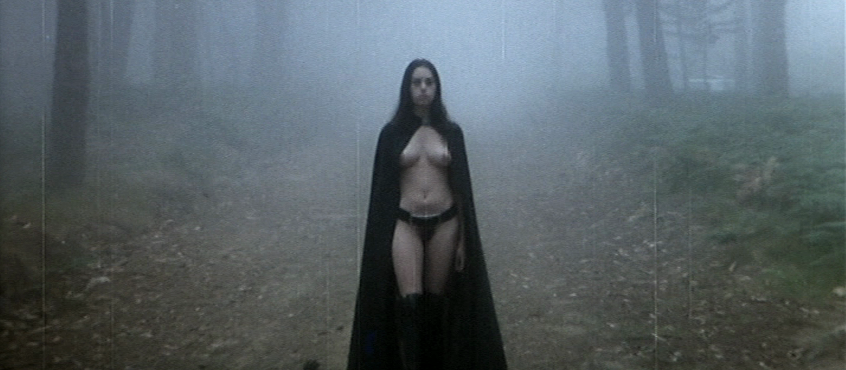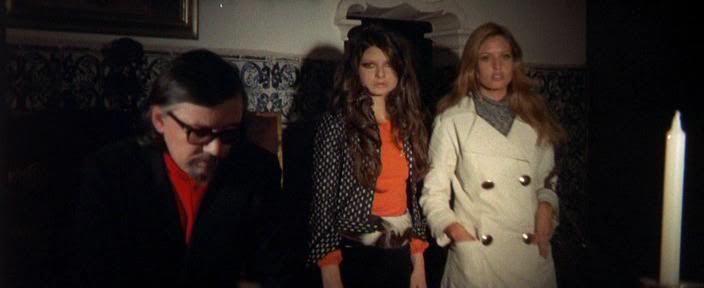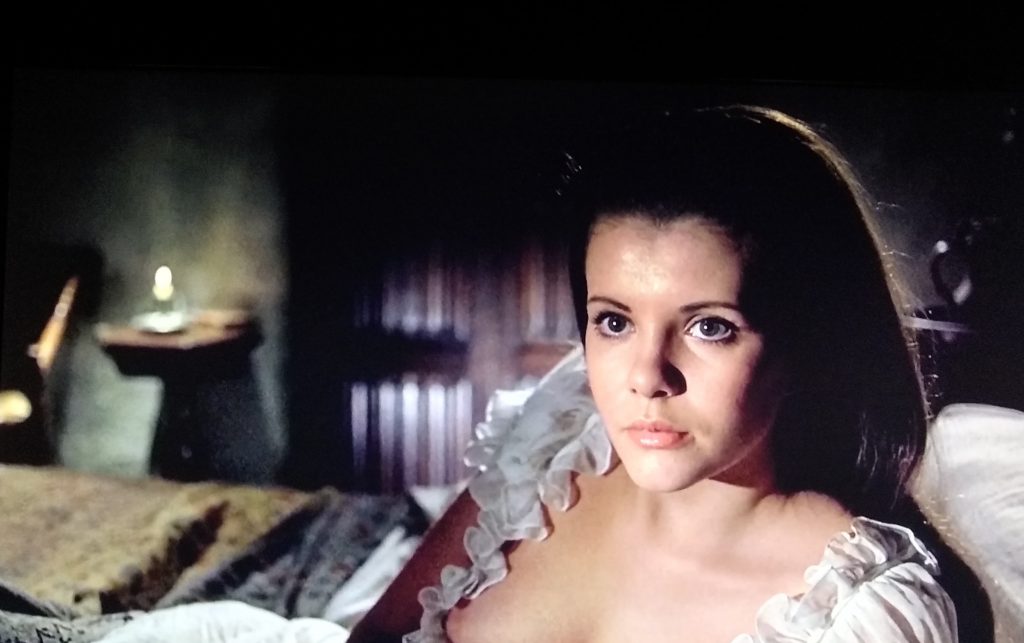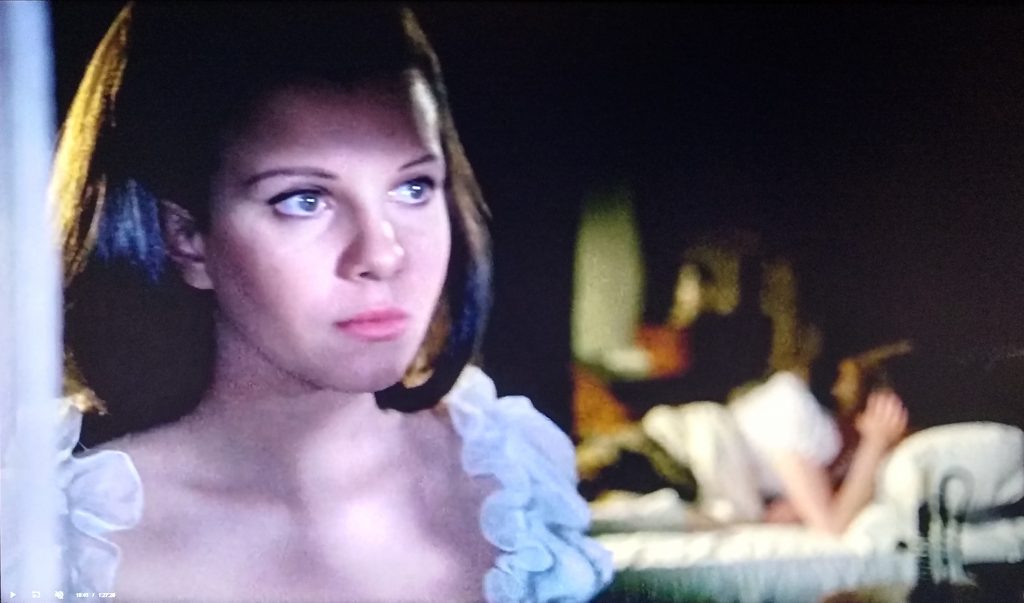Shudder has Twins of Evil, the third film in Hammer Films’ Karnstein Trilogy so–even though they’re not part of a single story–I had to hunt down the first two and watch them in order.
Previously:
- November 2015 – Jess Franco films including his Karnstein/Carmilla-inspired Female Vampire
- July 2018 – Franco’s Daughter of Dracula, another with a Karnstein vampire
Currently:
Table of Contents
Introduction to the genre
I don’t really love or hate the vampire genre, but back in November 2015 I’d just learned about the trashy/artsy director Jess Franco and watched three of his films to get a sense of his style. Succubus, a lewd suspense about an S&M performer and her unscrupulous psychiatrist. Two Undercover Angels, a sexcapade farce described by one site, with pinpoint accuracy, as: “What if Abbott and Costello had made a parody of Judex or Fantomas and what if that somebody replaced Abbott and Costello with a pair of sexy lesbians?” And Female Vampire (which possesses a wealth of aka’s, including: Bare Breasted Countess, Sicarius – the Midnight Party, The Black Countess, The Last Thrill, The Loves of Irina, and Erotikill). It is based on the Karnstein myth and the actual first vampire novel, Carmilla, written in 1872 by Joseph Sheridan Le Fanu. Female Vampire has Lina Romay as the mute lead suffering from the Karnstein family curse, killing through sex, but alone for eternity.
All three unique and recommended.

Cut to July 2018 and one of the first films after getting my Shudder subscription is Franco’s Daughter of Dracula, another Carmilla-influenced film. Here, Carmen Yazalde learns that she is descended from the Karnstein family as the town is terrorized by mysterious murders. The local inspector searches for the killer.

The Hammer Films trilogy
Streaming options for the Hammer Films trilogy:
- The Vampire Lovers (1970) available from Amazon Prime
- Lust for a Vampire (1971) available from Amazon Prime
- Twins of Evil (1971) available from Shudder
These films are available in low-quality, edited, pan and scan form on DailyMotion. Avoid.
There’s a classic Hammer look. The muted color contrast, the sound stages, the 70s style even though it’s the 1700s, just everything. It feels like Saturday middle-of-the-night creepy movie fare when I was 12. But also a bit like a made-for-TV movie. Hammer put out lots of Frankenstein/Dracula/Mummy movies, but also the sci-fi horror pic Five Million Years to Earth! I loved/still love that film: a weird space ship from Mars populated by giant grasshoppers is dug up in the London Underground. It ends up being the source of supernatural events that had been recorded in the region for centuries and making it the source of superstitious wives’ tales. As the aliens are awakened, the citizens become hypnotized and manic and the devil shows up–as a 10 story high ghostly, horned specter–at the climax of the film.
The Vampire Lovers

The Vampire Lovers has the look of a Hammer film with an added Gothic feel. In it, Marcilla/Carmilla/Mircalla (anagram alert!) ingratiates herself to the aristocracy in two wealthy 1790s British estates and seduces the innocent wards in each. The first, the owner’s niece Laura, eventually succumbs to having her blood slowly drained over several days. When her death is discovered, Carmilla flees with her mother and after their carriage breaks down is taken in by the neighboring estate owners who are unaware of her recent and fatal activities. There, as the owner is away, she seduces and kills the help in turn as each begins to suspect she is the evil cause of the daughter Emma’s slow decline.
The film starts with a flashback to a vampire hunter killing all in the castle except Carmilla. Flash forward. All of the characters are introduced at a grand ball: the members of the two estates, the male suitors to Laura and Emma, and Carmilla and her mother. The conceit of Carmilla travelling the countryside without neighbors connecting her identities worked well. In the end, the connection is of course made with a book-ended coming together of many of the characters in the first scene, including the now older vampire hunter. A stake is driven and her head is chopped off for good measure.
- The Ingrid Pitt Column: The Vampire Lovers from Den of Geek – The lead’s reminiscences of making the film. Entertaining!
Lust for a Vampire

The previous film took place in 1790, Lust for a Vampire takes place in 1830. When an innkeeper at the start warns that the Karnsteins appear every 40 years, the connection is made for the viewer. The film also uses what appears to be the same Karnstein castle set as the previous, along with Carmilla’s same, inscribed tomb just outside the castle.
The film start like the previous: an introductory scene with the Karnsteins, this time performing a ritual to resurrect Carmilla (spoiler: successfully). It then moves to main arc of the film. A self-confident writer, Lestrange, visiting a hamlet for inspiration encounters a school of beautiful girls and waylays the incoming literature professor in order to, lecherously, take over his classes. Carmilla has become a student there, and his time as teacher turns the seducer into the seduced. After many unsolved-but-suspicious murders, one being the history professor who became a Renfield to Carmilla’s Dracula, the townspeople angry mob themselves to the cursed castle and burn it down. In his uncontrolled obsession, Lestrange rushes into the flames to same Carmilla but is instead attacked by her. A weakened wooden roof support splinters and falls and–well, we all saw this coming–pierces Carmilla through the heart. He is mad with grief but is comforted by the female student who truly loves him
This had that finishing school, wistful period piece atmosphere, with a bit of Harlequin romance and The Twilight Saga. There was an incongruously bold yet cringey sex scene at one point, but the film is otherwise unremarkable with expected camp silliness.
(Random observations: on of the female acolytes present at the beginning when Carmilla is resurrected has a red, teardrop pendant like the one Carmilla wears in the previous film. When Lastrange discovers Giles’ research of Carmilla, the soundtrack plays a sly quote of Dies irae.)
- Lust for a Vampire from Trailers from Hell. The author has a deep knowledge of the genre and hates this film (as do most of the actors), but agrees with my Twilight Saga comparison.
- Scream Factory Friday: Lust For A Vampire from Morbidly Beautiful – A kinder review of the Blu-ray. Both, however, appreciated the lush clarity of this 4K release.
Twins of Evil


Twins of Evil was the best of the three. It opens as it closes: bookended with a witch/vampire being burned at the stake, but each having dramatically unique intents. The first burning is led by a righteous Peter Cushing (who looked the same his entire life) and his band of angry fundamentalists ready to wipe evil from the land.
Carmilla is resurrected with blood again, this time accidentally by a younger, decadent Count Karnstein as he kills a virgin in the hopes of being granted the power of evil! The scenes with him are pretty hammy as he praises Satan and how much fun debauchery is. After some dialogue of some sort, she turns him into a vampire and proves it by both standing in front of a mirror. No reflection! Now, it’s interesting to note that this is the first of the movies that included this standard vampire characteristic, and the movie’s leads are twins. After these scenes, Carmilla is pretty much out of the picture.
Aside: I’m not sure of the time-frame and genealogy here and whether the count and Carmilla are related and whether this follows the 40-year resurrection law. Back in my 2018 viewing of Daughter of Dracula, I found an unbelievably obsessive website that documents the Karnstein history from–and I am not making this up–20,000 BCE to 2011: The Karnstein Timeline. I will defer to it for this knowledge.
The twins of evil proper enter unevilly from out of town to become wards of Cushing, their uncle, after their parents had died in… Vienna I think? They immediately clash with the pious elder, being decadent big city girls with fancy frocks. Maria, the good twin, is unhappy but wants to obey. Frieda, the bad-soon-to-be-evil twin, has other plans and one night sneaks out to party with Karnstein at his castle where with some cajoling she is turned and feeds on a peasant girl. What follows is some fragmented vignettes of Frieda sneaking out at night to hunt and feed.
When Frieda is eventually caught, Cushing is horrified yet sympathetic. His wife makes the socially-conscious comment that disciplining children sometimes actually pushes them to rebellion and evil. Finally, we get a well-done twin twist, the final attempted stake burning, and another storming of Karnstein castle.
After watching so much of this mythology, I start seeing a through line both dramatically and of the narrative: repeated actors, the mirrored first and last scenes (to emphasize what has been accomplished), a girls school (to skip easily to the lesbian themes). I’m sure there are more Karnsteiny stuff out there (again, the above-linked The Karnstein Timeline), but I’ve had my fill for now. I recommend this film, maybe the first, and the second only if you need to kill time with a bad movie.